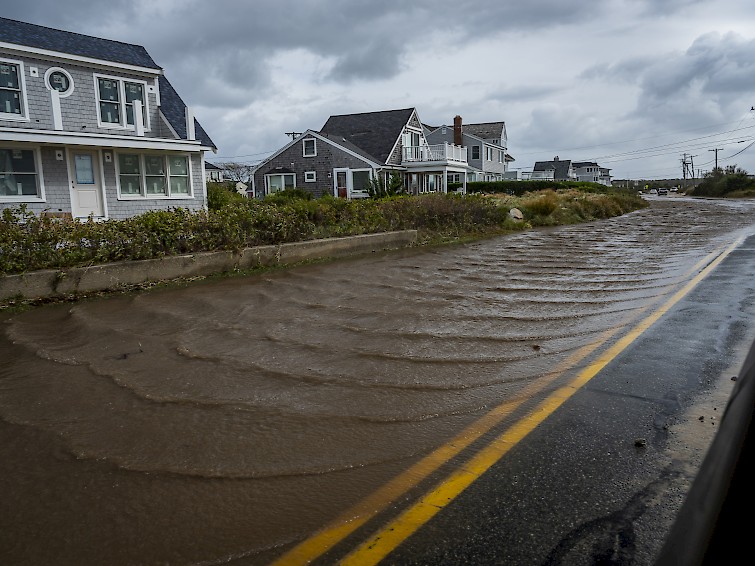In March 2021, a Cape Cod weather station in Chatham, Massachusetts was abandoned due to coastal erosion. With much media coverage, some of the articles mentioned that the situation is likely to worsen. The fact that they associated the erosion with climate change and that it was a weather station yielding research data about the changing climate added some irony.
For professionals in the diverse fields of preparedness, it is worth a deeper look to grasp how coastlines are changing profoundly. Erosion, flooding, and rising sea level are all at work, but with very different dynamics and implications for short-term and long-term preparedness. It is important for professionals to understand each in order to prepare for the new normal and unexpected emergencies.
Erosion
Erosion is best thought of as two different types: incremental and abrupt. Think of them as routine and storm driven. At the water’s edge of any sandy beach, when the seas are calm, it is possible to see the ripples of water carrying sand particles along the shoreline with the current. Even without storms and big waves, that is part of the process that takes unconsolidated sediments. By itself, it would gradually change landforms. Coastal experts routinely identify and document the migration of coastlines. Wherever a new harbor inlet or groin (i.e., a barrier constructed from a beach into the sea to check erosion) is established, the process changes dramatically, with sand piling up on one side and depleting on the other, due to interrupted sand flow. These processes even occur in lakes, though the ocean environment usually is more significant.
Crashing waves during storms is a different form of erosion. In the article about the Chatham weather station, it described the station originally being a hundred feet in from the shore. On one single stormy day, the ocean removed enough land to move the shore six feet inland. Still, they thought they had 10 years of safety. Recent erosion accelerated the projected erosion by 10 years. Such coastal beach erosion is becoming common all over the world. Beach restoration has become a huge industry that is becoming evermore expensive as the areas increase and the supply of quality sand becomes scarcer.
Flooding
In coastal communities all over the world, there is also increased flooding. One source is the record-breaking rainfall, which was anticipated as the warming oceans evaporate more. In turn, heavier rainfall moves downslope, downstream, or just down to a lower street, multiplying the actual rainfall. In 2017, Hurricane Harvey hitting Texas showed an extreme example with 40 in. of rain, more than doubling water depth at underpasses, which obstructed evacuations. Even without storms, coastal areas are seeing more flooding with clear skies and calm weather. “Sunny day flooding” is now routine during king tides, when the planetary pull on the ocean is at its peak. The planets are not getting any closer or increasing in mass. What is changing is that the base ocean height – that is, sea level – is rising ever higher.
Rising Sea Level
It is hard to notice sea level rise because the global average rate now is only about a quarter inch per year (6 mm). However, like a drip filling a bucket, the stealthy accumulation makes its mark. It is so gradual – and follows rather obscure tidal patterns – that the mysterious routine flooding is easy to dismiss and overlook. The problem, however, is that the rate of sea level rise is accelerating. Last century, the rate of rise was less that 2 mm a year. Now it is almost 5 mm a year and accelerating by each decade (see Fig. 1).

Fig. 1. Graph showing the acceleration of sea level. Over the past century, global average sea level increased at approximately 1.7 mm a year, which would only be about six inches a century. In the last 30 years, the rate has almost tripled and is accelerating. (Source: Adapted from “Moving to Higher Ground: Rising Sea Level and the Path Forward,” 2021).
Since 1993, when precise satellite measurement of global sea level started being recorded, the rate of rise has been accelerating dramatically. Though it still is only fractions of an inch a year, the current rate of rise would raise global ocean levels one and half feet in 100 years (50 cm). However, at the current rate of acceleration, sea level could rise several times that. The latest NOAA extreme projection is over 8 feet this century. Projections have been increasing.
Projections from the COVID-19 pandemic have illustrated the extreme effects that rapid changes of rate could have, particularly when growth becomes exponential. Looking back in Earth’s history, the lessons are clear. Geologic history may be a lot more relevant than the usual lookback period of 30 or 100 years. Just 11,000 years ago, global sea level was rising at the rate of more than a foot per decade. It did that for 400 years, rising some 65 feet.
Regardless of the effort and success in stopping the current human-induced warming, there is a need to begin designing for higher water to come. Even if it were possible to convert to 100% renewable energy, the ice sheets of Antarctica and Greenland would still melt for a long time, raising sea level. The quite stable sea of the last 6,000 years has been deceiving. Rising sea level, extreme tides, and coastal erosion will all challenge communities to think differently about the changing coastline. To be prepared, communities need to understand, plan for, and adapt to what is inevitably coming.

John Englander
John Englander is an oceanographer, consultant, and leading expert on sea level rise and related flooding. His broad marine science background, with degrees in geology and economics and personal experience in Greenland and Antarctica, allow him to see the big picture on sea level rise and explain the phenomena in plain language. He works with businesses and government agencies to understand the risks of sea level rise and the need for intelligent adaptation. Englander goes beyond the usual projections and explains the uncertainties that could yield considerably higher sea level as early as mid-century. His bestselling book, “High Tide on Main Street: Rising Sea Level and the Coming Coastal Crisis” (2012), clearly explains the science of sea level rise, the impending devastating economic impacts, and the opportunity to design for a more resilient future. In his new book, “Moving to Higher Ground: Rising Sea Level and the Path Forward” (2021), he expands on that science and what now needs to be done to address this threat. He has given Congressional testimony, and has presented to national security leadership, the American Planning Association, American Institute of Architects, U.S. Coast Guard Academy, U.S. Naval Academy, etc. His weekly blog and news digest “Sea Level Rise Now” can be accessed at www.johnenglander.net
-
John Englanderhttps://www.domesticpreparedness.com/author/john-englander
-
John Englanderhttps://www.domesticpreparedness.com/author/john-englander






